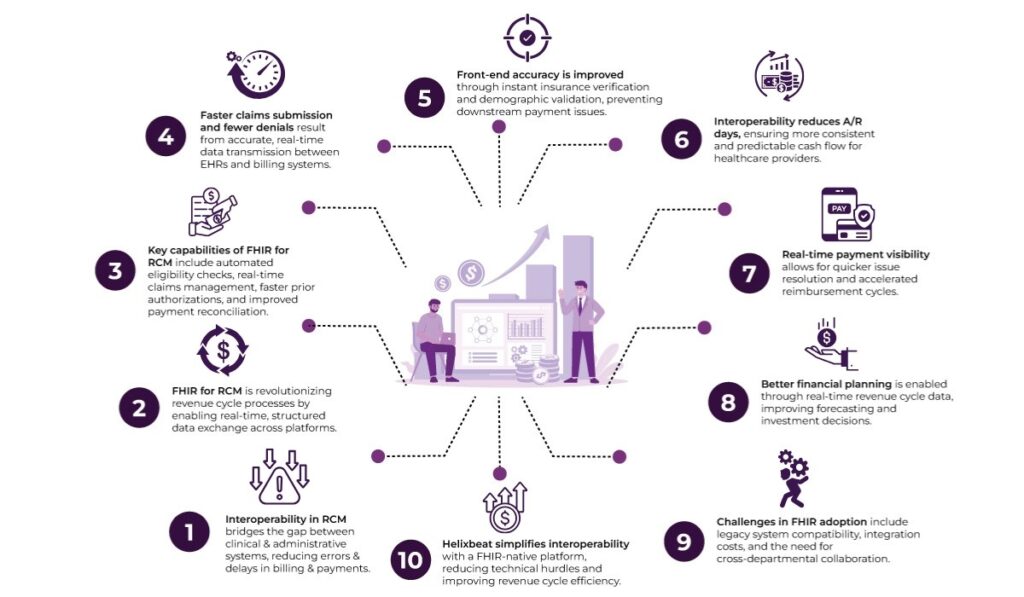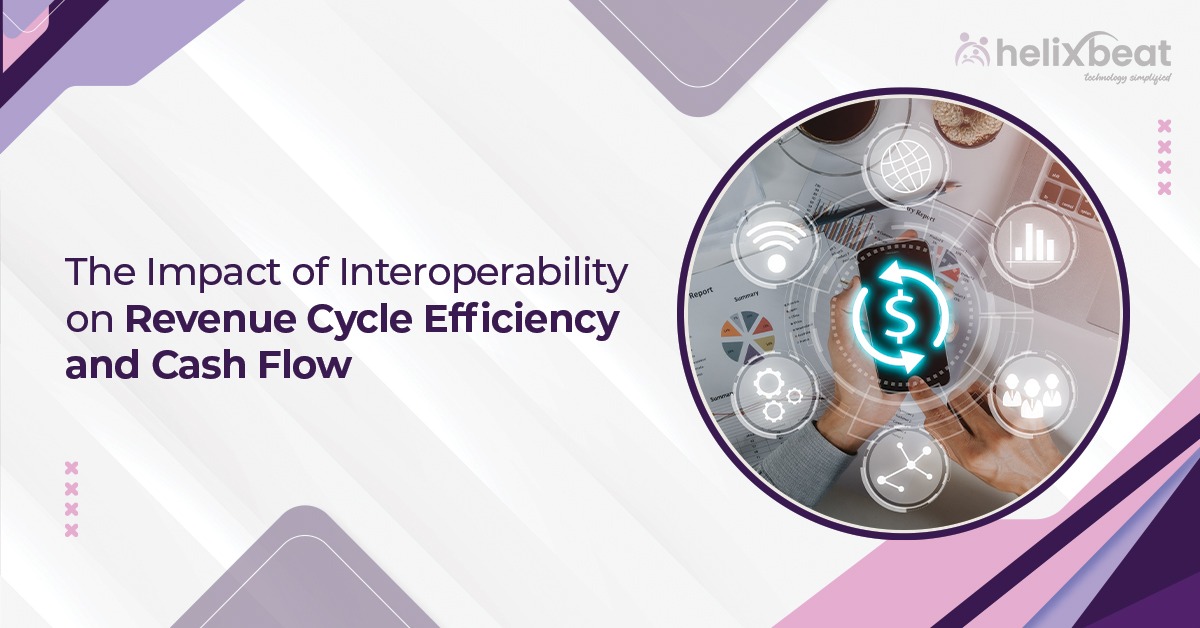Picture this: a patient receives excellent care, the provider submits the claim, and then… silence. Weeks pass before the payment arrives—if it arrives correctly at all. Behind the scenes, it’s often a mess of disconnected systems, inconsistent data, and manual follow-ups. For many healthcare organizations, this is a daily reality.
But change is happening. Healthcare interoperability is stepping as a powerful driver of financial clarity and operational speed. FHIR for RCM is leading this transformation, a framework that simplifies billing, reduces errors, and accelerates payment cycles.
Let’s dive into how FHIR for RCM is reimagining the revenue cycle—and what that means for better cash flow and smarter healthcare operations.
Table of Contents
Why Interoperability Matters in RCM
Interoperability refers to the ability of different systems and software applications to communicate, exchange, and interpret shared data accurately and in real-time. In revenue cycle management, interoperability bridges the gap between clinical and administrative systems, enabling smoother data exchange between providers, payers, and clearinghouses.
When systems operate in silos, it often leads to duplicative data entry, manual reconciliation, and data errors—all of which directly impact reimbursement speed and cash flow. This is where FHIR for RCM comes into play. By leveraging standardized data formats and real-time communication protocols, FHIR for RCM enhances interoperability, eliminating roadblocks and enabling seamless integration across platforms. The result is faster billing cycles, fewer errors, and improved financial outcomes for healthcare organizations.
FHIR for RCM: A Game-Changer
FHIR (Fast Healthcare Interoperability Resources), developed by HL7, is a modern data standard that simplifies healthcare information exchange. FHIR is modular, developer-friendly, and designed for flexibility and scalability. Its relevance in revenue cycle processes is increasingly evident as it promotes real-time connectivity between disparate systems.
When applied to revenue cycle management, FHIR for RCM enables the exchange of patient demographics, insurance eligibility, benefits information, prior authorizations, clinical documentation, and claim statuses in a structured, machine-readable format. This not only accelerates administrative workflows but also boosts accuracy across the board.

Key Capabilities of FHIR for RCM
- Eligibility Checks: Automated verification of insurance eligibility at the point of care.
- Claims Management: Real-time claims submission and status tracking.
- Prior Authorization: Faster and transparent authorization processes with pre-approved data flows.
- Clinical-to-Administrative Data Mapping: Streamlined transition from clinical documentation to billing codes.
- Payment Reconciliation: Better visibility into payments, adjustments, and patient balances.
Impact on Revenue Cycle Efficiency
1. Faster Claims Submission and Fewer Denials
One of the most common pain points in RCM is claim denial, often due to missing or incorrect information. With FHIR-enabled interoperability, patient data, clinical notes, and coding information are transmitted accurately and in real time between EHRs and billing systems. This significantly reduces the likelihood of claim errors and speeds up the submission process.
Moreover, payers can respond faster to electronic claims when they’re structured using FHIR resources, as they require less manual intervention to interpret.
2. Streamlined Patient Access and Front-End Accuracy
Accurate data at the front end of the revenue cycle—such as insurance eligibility, demographic verification, and copay estimation—is critical to prevent downstream denials. FHIR-based APIs help verify coverage instantly during registration or scheduling. This level of data transparency enables providers to capture the right details early and collect payments more effectively at the point of service.
3. Improved Documentation and Coding
Proper documentation and coding are vital for appropriate reimbursements. Through FHIR, clinical systems can communicate with coding platforms, making it easier for coders to access structured notes, lab results, diagnoses, etc. This reduces the burden of manual chart reviews and improves the accuracy of coding, ultimately leading to quicker payments.
Impact on Cash Flow
1. Reduced Days in Accounts Receivable (A/R)
Interoperability expedites the end-to-end billing process—from registration to claim submission to payment posting. With fewer claim errors and faster resolution of denials, providers can reduce their average days in A/R, leading to more predictable and consistent cash inflows.
2. Accelerated Payment Processing
With FHIR for RCM, providers can gain immediate visibility into the status of submitted claims and electronic remittances. This real-time feedback allows billing teams to respond proactively to payer requirements, fix issues quickly, and close the revenue loop sooner. Faster turnaround from submission to payment has a direct, positive impact on cash flow.
3. Better Financial Planning and Forecasting
Real-time access to revenue cycle data allows CFOs and RCM leaders to monitor key performance indicators (KPIs) such as claim denial rates, A/R aging, collection efficiency, etc. These insights support better cash flow forecasting and enable smarter investment decisions in staffing, infrastructure, and patient services.
Overcoming Challenges in Implementing FHIR for RCM
Shifting to a FHIR-based ecosystem isn’t always smooth. Many healthcare systems still rely on legacy infrastructure, where EHRs and billing platforms weren’t built for FHIR compatibility. Also, retrofitting these systems to work within a FHIR ecosystem often requires custom integration layers, which can be time-consuming and costly.
There’s also the human side of transformation. Bringing clinical, IT, and finance teams together under one unified data-sharing approach is no small feat. Without alignment, even the best technical solutions may fall short. And then there’s the challenge of data governance—navigating HIPAA, patient privacy rules, and secure exchange protocols, all while trying to innovate.
That’s where Helixbeat enters the picture—not just as a solution, but as a strategic partner. Built on a FHIR-native architecture, Helixbeat eliminates many technical and operational hurdles from day one. Its prebuilt RCM modules support automated coding and billing, making revenue cycle tasks faster and less error-prone.
Similarly, with plug-and-play interoperability, Helixbeat enables seamless integration with existing systems, even if they weren’t designed for FHIR. Real-time data exchange becomes a standard capability, not an afterthought—helping providers track claims, verify coverage, and reduce denials without delays.
Moreover, the platform complies fully with HL7 and FHIR standards, providing peace of mind when handling sensitive patient and financial data.
Final Thoughts
Interoperability is not just about connecting systems; it’s about unlocking value across the revenue cycle. By enabling real-time, accurate, and context-rich data exchange, FHIR for RCM helps healthcare providers streamline workflows, reduce claim errors, speed up reimbursements, and strengthen cash flow.
With Helixbeat, you can accelerate your digital transformation without disrupting your existing systems. Explore how Helixbeat can help your organization simplify RCM, stay compliant, and improve revenue outcomes—all through the power of FHIR.
Let’s build a smarter, connected healthcare system—start with Helixbeat.
FAQs
1. How does interoperability improve revenue cycle efficiency?
Interoperability allows different systems—such as EHRs, billing platforms, and payer databases—to communicate in real-time. This connectivity minimizes data entry errors, speeds up claim submissions, and enhances workflow coordination across departments.
2. What are the key benefits of using FHIR for RCM?
Some major benefits include faster eligibility checks, real-time claims tracking, quicker prior authorizations, seamless coding transitions from clinical documentation, and more transparent payment reconciliation.
3. How does Helixbeat support the transition to FHIR for RCM?
Helixbeat offers a FHIR-native ecosystem with prebuilt RCM modules, plug-and-play interoperability, and real-time data exchange capabilities—making it easier for organizations to adopt FHIR without overhauling existing infrastructure.
4. What long-term value does FHIR for RCM bring to healthcare organizations?
Beyond operational efficiency, FHIR for RCM enables better financial forecasting, improves the patient experience through faster service and billing, and positions organizations for success in a value-based care environment.
5. Is FHIR for RCM compliant with industry regulations?
FHIR itself is designed in alignment with HL7 standards. Therefore, Helixbeat’s solutions also align with HIPAA and data privacy requirements while supporting secure, scalable interoperability.














